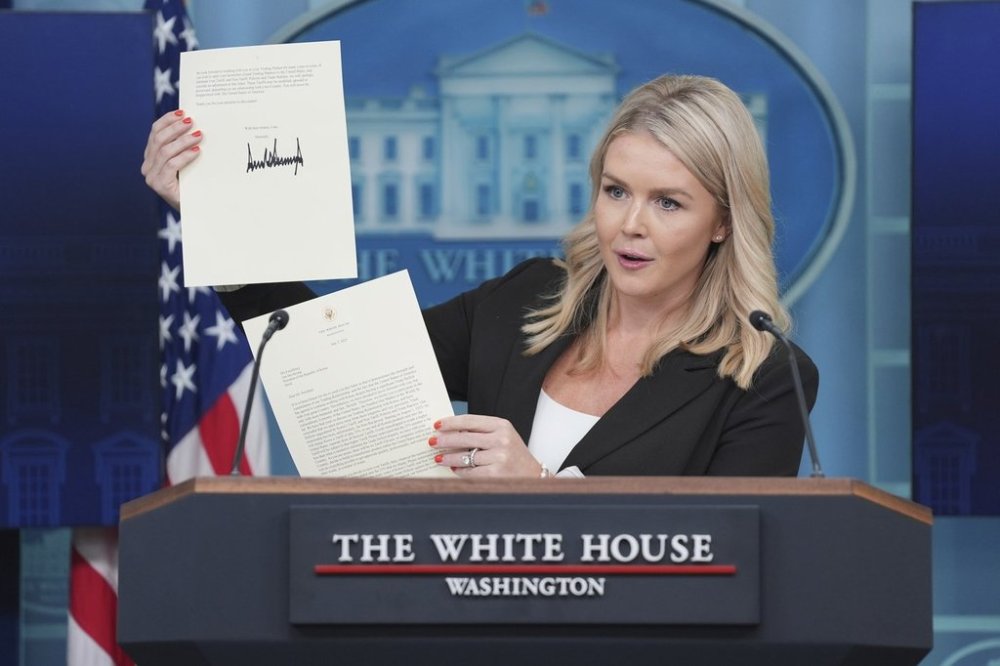To Whom it May Concern: Trump’s tariff letters cause a stir among world leaders
Advertisement
Read this article for free:
or
Already have an account? Log in here »
To continue reading, please subscribe:
Monthly Digital Subscription
$0 for the first 4 weeks*
- Enjoy unlimited reading on winnipegfreepress.com
- Read the E-Edition, our digital replica newspaper
- Access News Break, our award-winning app
- Play interactive puzzles
*No charge for 4 weeks then price increases to the regular rate of $19.00 plus GST every four weeks. Offer available to new and qualified returning subscribers only. Cancel any time.
Monthly Digital Subscription
$4.75/week*
- Enjoy unlimited reading on winnipegfreepress.com
- Read the E-Edition, our digital replica newspaper
- Access News Break, our award-winning app
- Play interactive puzzles
*Billed as $19 plus GST every four weeks. Cancel any time.
To continue reading, please subscribe:
Add Free Press access to your Brandon Sun subscription for only an additional
$1 for the first 4 weeks*
*Your next subscription payment will increase by $1.00 and you will be charged $16.99 plus GST for four weeks. After four weeks, your payment will increase to $23.99 plus GST every four weeks.
Read unlimited articles for free today:
or
Already have an account? Log in here »
Ninety trade deals in 90 days didn’t happen early in President Donald Trump’s second term. “Liberation Day” panicked the financial markets in April. And bespoke trade agreements with dozens of countries, he has said, takes too much time. “There’s 200 countries,’’ the president acknowledged. “You can’t talk to all of them.’’
So Trump repackaged his plan to slap tariffs on almost every nation in a series of unusual presidential letters to foreign leaders that set new thresholds not just for trade negotiations — but also for diplomatic style, tone and delivery. Most are fill-in-the-blank form letters that include leaders’ names and a tariff rate. Words are capitalized using Trump’s distinct social media style. A few typos and formatting issues appear throughout.
They generally include an opening flourish of salutation, a grievance, the threat of a big jump in tariffs, a new deadline and an escape ramp allowing that “we will, perhaps, consider an adjustment to this letter” if certain conditions are met. Rather than typical diplomatic talk of things like enduring mutual respect, Trump closes with, “Thank you for your attention to this matter!” and “Best wishes,” followed by his signature of three long strokes linked by and about 14 short ones.

He appears to have paid special attention to his letters to Canada, with which he’s been fighting and taunting for months, and Brazil, which he singled out for 50% tariffs apparently based on a personal grudge rather than economics.
A negotiation tactic
The good news for the leaders of foreign countries, Trump suggested, is that if he sent you a letter, he wants to negotiate.
“A letter means a deal,” he said during a Cabinet meeting. “We can’t meet with 200 countries.”
But he’s also managed to make his erratic trade policy baffling for American trading partners eager to negotiate a way to dodge his wrath. The president escalated a conflict he started with America’s second-biggest trading partner and longstanding ally, raising the tariff — effectively a tax — on many Canadian imports to 35% effective Aug. 1. On Saturday, Trump announced more tariffs still, this time on two of the United States’ biggest trade partners: the European Union and Mexico, at 30% each.
And it’s far from clear that these tariffs would benefit Americans’ bottom lines. Trump’s threat to boost import taxes by 50% on Brazilian goods could drive up the cost of breakfast in the United States by making staples of the American diet, such as coffee and orange juice, more expensive.
Reception has been … spotty
The response to the letters, which the White House says will also be mailed, has been mixed.
Canadian Prime Minister Mark Carney’s office issued a mild statement acknowledging the new Aug. 1 deadline and suggesting he would stay the course “steadfastly defend(ing) our workers and businesses.”
Brazilian President Luiz Inácio Lula da Silva, meanwhile, vowed retaliatory tariffs and ordered his diplomats to return Trump’s letter if it ever physically arrives at the presidential palace in Brasilia.
“Respect is good,” Lula told TV Record. “I like to offer mine, and I like to receive it.”


